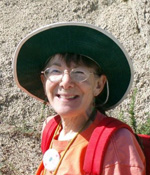PUBLICATIONS
-
Anderson, J.E. and Robbins, E.I., 1998, Spectral reflectance and detection of iron-oxide precipitates associated with acidic mine drainage, Photogrammetric Engineering and Remote Sensing, 64:1201-1208.
-
Brant, D.L., Ziemkiewicz, P.F., and Robbins, E.I., 1999, Passive removal of manganese from acid mine drainage at the Shade mining site, Somerset County, Penna. (USA), Sudbury ë99, Mining and the Environment II, 3:1241-1249.
-
Gross, Sabine and Robbins, E.I., 2000, Acidophilic and acid-tolerant fungi and yeasts, Hydrobiologia, 433:91-109.
-
Jiang, DeXin and Robbins, E.I., 2000, Quaternary palynofloras and paleoclimate of the Qaidam basin, Qinghai Province, Northwestern China, Palynology, 24:95-112.
-
Lopez, D.L., Overly, Bryan, Robbins, E.I., and Carroll, Kenneth, 1999, The role of flow regime on the chemical evolution of acidic waters discharged from an abandoned underground coal mine, Sudbury ë99, Mining and the Environment II, 1:89-98.
-
Robbins, E.I., 1998, Historical overview and future directions of microbial role in the acidic coal mine drainage system: Proceedings, 15th Annual American Society for Surface Mining and Reclamation Meeting, St. Louis, MO, p.174-191.
-
Robbins, E.I., 1998, The JIMES expedition to Santorini, Greece: Iron bacteria and educational outreach at the Precambrian iron formation analog, Wat on Earth (Newsletter of University of Waterloo), p.15-17 http://www.science.uwaterloo.ca/earth/waton/watons98.html.
-
Robbins, E.I., 1998, New roles for an old resource, Ferromanganese nodules assist mine cleanup, Geotimes, 43:14-17.
-
Robbins, E.I., 1999, Microbial and spectral reflectance techniques to distinguish neutral and acidic drainage: U.S. Geological Survey Fact Sheet FS-118-99, 4p.
-
Robbins, E.I., 2000, Bacteria and Archaea in acidic environments and a key to morphological identification, Hydrobiologia, 433:61-89.
-
Robbins, E.I., 2000, Teaching and learning science from Native Americans [abs.], Eos, Transactions American Geophysical Union, 81:S64.
-
Robbins, E.I., 2001, Manganese oxidation by organisms in Pinal Creek, Arizona, photomicrographs, http://mam.er.usgs.gov/mfs.html.
-
Robbins, E.I., Anderson, J.E., Cravotta, C.A, III, Nord, G.L., Jr., and Slonecker, E.T., 2000, Multispectral reflection variations in acidic versus near-neutral iron-bearing drainage in Pennsylvania, ICARD 2000, Proceedings of the 5th International Conference on Acid Rock Drainage, 2:1551-1559.
-
Robbins, E.I., Anderson, J.E., Podwysocki, M.H, and Nord, G.L., Jr., 2001, Seasonal variations in spectral reflectance of microbial flocculates, precipitates, and oil-like films associated with neutral and acidic mine drainage, in Healy, M., Wise, D.L., and Moo-Young, M., eds., Environmental Monitoring and Biodiagnostics of Hazardous Contaminants, Kluwer, p.243-266.
-
Robbins, E.I., Brant, D.L., and Ziemkiewicz , P.F., 1999, Microbial, algal, and fungal strategies for manganese oxidation at a Shade Township Coal Mine, Somerset County, Penna., 16th Annual Meeting, American Society of Surface Mining and Reclamation, Phoenix, AZ, Proceedings, 2:634-640.
-
Robbins, E.I., Corley, T.L., and Conklin, M.H., 1999, Manganese removal by the epilithic microbial consortium at Pinal Creek near Globe, Arizona, in Morganwalp, D.W., and Buxton, H.T., eds., U.S. Geological Survey Toxic Substances Hydrology Program, Water- Resources Investigations Report 99-4018A, 1:247-258.
-
Robbins, E.I., Cravotta, C.A., III, Savela, C.E., and Nord, G.L., Jr., 1999, Hydrobiogeochemical interactions in “anoxic” limestone drains for neutralization of acidic mine drainage, Fuel, 78:259-270.
-
Robbins, E.I., and Harthill, Michalann, in press, Life in a copper province, in Selinus, O. (ed.), Medical Geology: Academic Press.
-
Robbins, E.I., Rodgers, T.M., Nordstrom, D.K., and Alpers, C.N, 2000, Ecogeochemistry of the subsurface food web at pH 0-2.5 in Iron Mt., California, U.S.A., Hydrobiologia, 433:15-23.
-
Sato, Motoaki and Robbins, E.I., 2000, Recovery/removal of metallic elements from acid mine drainage using ozone, ICARD 2000, Proceedings of the 5th International Conference on Acid Rock Drainage, 2:1095-1100.
-
Sato, Motoaki, Robbins, E.I., and Iberall, A.S., 2000, Thermochemistry of the origin of life and the optimal environment [abs.], American Chemical Society, Division of Geochemistry Abstracts, 219th ACS National Meeting, San Francisco, CA, Abstract No. 57.
-
Robbins, E.I., Kourtidou-Papadeli, C., Hanert, H.H., Sato, M., Iberall, A.S., and Slonecker, E.T., 2000, Volcanic hot springs as clues to the precipitation of Precambrian iron formation, origin of life, and terraforming Mars [extended abs.], 13th International Academy of Astronautics Humans in Space Symposium, Santorini, Greece, Abstract Volume p.19-20.
-
Robbins, E.I., McSurdy, S.L., and Craddock, T.D., 2000, Hands-on experiments to test for acid mine drainage, U.S. Geological Survey Open-File Report 00-369, http://pubs.usgs.gov/openfile/of00-369/.
|


